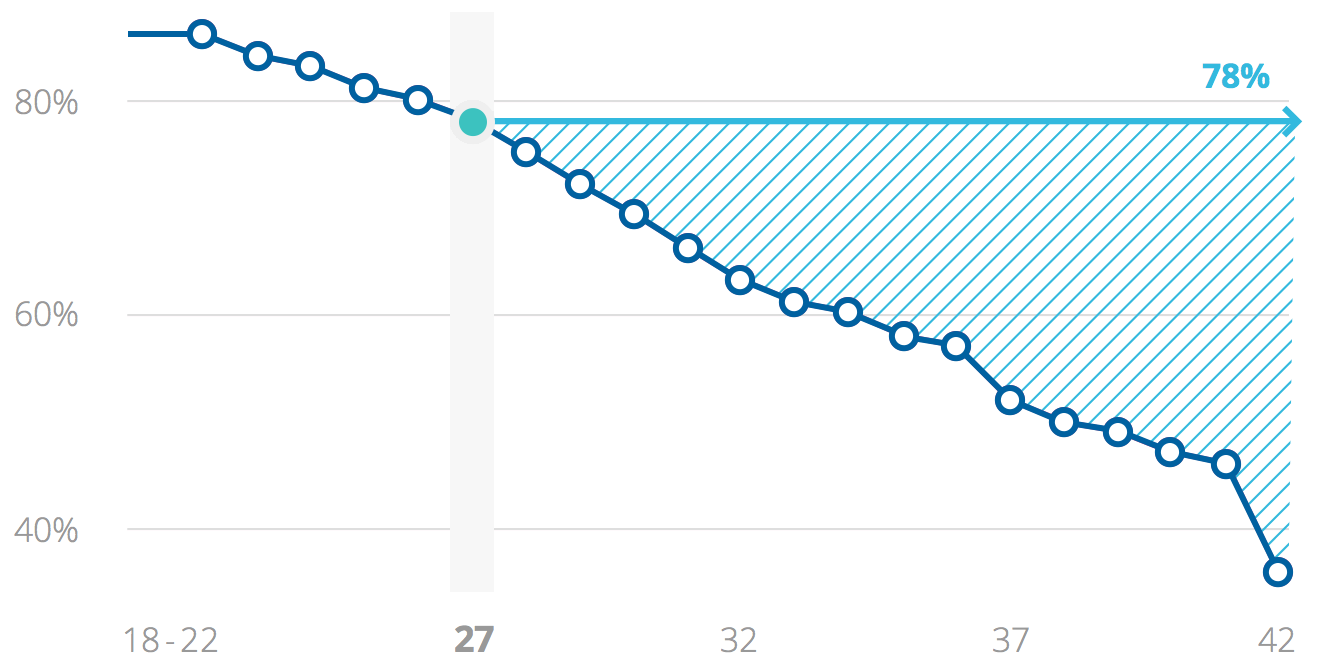One of the issues that most worries a woman when she starts having problems getting pregnant is how to calculate her fertile days, in other words, the days when sexual intercourse is most likely to result in pregnancy. We know that, once an egg has been released at ovulation, the egg lives for about 24 hours, while sperm can live for up to five days on their journey to the fallopian tube. Taking into account the woman’s cycles, her age and other factors that we will see below, we can obtain the chances of getting pregnant on ovulation day.
The greatest chance of getting pregnant would be in a window of about six days: the five days prior to the release of the egg from the fallopian tube and the day of ovulation itself. This six-day window is the period when a woman’s fertility is highest.
In any case, not all days are equally fertile. In general, there are chances of getting pregnant the day before ovulation and the ovulation day, but this varies according to a series of parameters. In addition, at Eugin, thanks to our assisted reproduction techniques and treatments, we can help you increase your chances of pregnancy, as we will see below.
How to calculate a woman’s ovulation days?
If we had an ovulation calculator to know the fertile days for getting pregnant, it would take into account when menstruation occurs. That is, the time when the egg is not fertilised, between days 21 and 35 of the cycle. The first day of menstruation is considered day one of that ovarian cycle. The best time to conceive is the day of ovulation. Therefore, the ideal time to have the best chance of getting pregnant on fertile days is to have intercourse several times in the days before, during and just after the egg is released.
Most women will ovulate again around day 14 in a 28-day cycle. But, as we know, cycles are not perfect and regular for most women. For that reason, it’s best to consider small signs that occur in your body that can help you pinpoint when you will ovulate:
- Basal body temperature rises by about half a degree at ovulation. Basal body temperature is the temperature we have when we wake up in the morning. In this case, we must take into account that this increase occurs when ovulation has already taken place, so it can be a way of calculating a posteriori.
- The change in cervical mucus: vaginal discharge increases in quantity and has a consistency similar to that of egg white when ovulating. The consistency can be seen by inserting the index finger and thumb into the vagina and then opening and closing the clamp formed by the two fingers on the outside. If the discharge is clear and stretchy and it stretches easily, the time is right.
Other ways of knowing a woman’s fertile days to get pregnant
An alternative method of calculating a woman’s fertile days is through ovulation tests, kits that detect an increase in the LH hormone. This surge normally occurs 36 hours before the egg is released. Ovulation tests are devices similar to pregnancy tests (they also need to be placed in contact with urine to find out the result).
The test should be done once a day, and always at the same time on the days closest to the cycle. It is recommended that the test be done after midday because the hormone usually peaks early in the day, but it takes a few hours for the hormone to be detected in urine.
According to experts, to know the ideal time to use them, you should subtract 17 days from your usual cycle length and then count them from the time of menstruation. For example: if your cycle is 30 days, you should subtract 17 days from 30 and start testing on the 13th day after your period starts.
Chances of getting pregnant after a positive ovulation test
Age
Without egg freezing
With egg freezing

Recommended age limit: 40
Chance of pregnancy
The best bet is still to have intercourse frequently (every other day if you can) around the fertile window, without waiting for a positive ovulation test, because when this happens you may have missed fertile days. The ideal is to have sex every two days shortly after you stop menstruating until your next period to cover the entire window, but with modern lifestyles this is sometimes difficult and can become an obsession that takes all the pleasure out of having sex. That is why, if you are trying to conceive, you should see a fertility specialist who can advise you so that you can improve your chances of getting pregnant on your fertile days.
Theoretically, within a 28-day cycle, days 1 to 7 would be the least fertile stage; on days 8 and 9 it is possible to conceive, and days 10 to 14 are the most fertile days; on days 15 and 16 there are still possibilities; and from day 17 onwards, the thickening of the uterus makes implantation of a fertilised egg in the uterus less likely.
It is important to understand, however, that it can take time to get pregnant, even if you have intercourse at the right time, because there are many factors involved, not just the frequency of intercourse: everything from age to the health conditions of your partner to the quality of your sperm can play a role. At Eugin we are specialists in assisted reproduction, so we can help you with many treatments, including several in which your age is not a determining factor. Make an appointment now and discover the success rate in IVF and other treatments such as artificial insemination.






